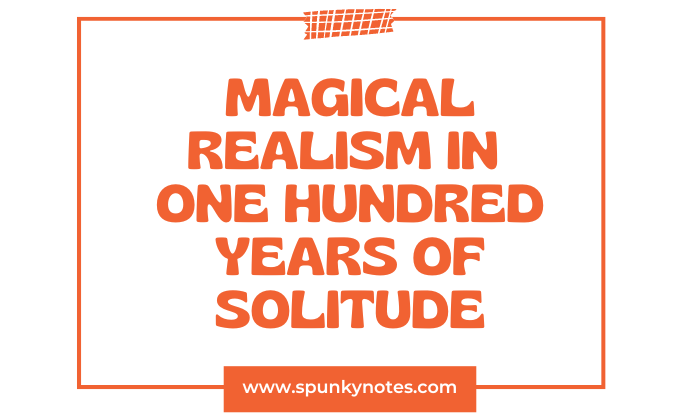
Q. What role does magical realism play in One Hundred Years of Solitude, and how does it affect the reader’s understanding of the Buendía family’s history?
Gabriel García Márquez’s One Hundred Years of Solitude is a powerful example of magical realism. This style allows extraordinary events to be treated as part of everyday life, seamlessly blending the magical and real.
In the novel, this mixture helps readers experience the history of the Buendía family from a unique perspective. Magical realism shapes how we see their lives, not just as a simple progression of events but as part of a larger cycle of repetition, destiny, and myth.
Magical Realism
In One Hundred Years of Solitude, magical events are treated as if they were completely normal. The characters do not question these unusual occurrences. For example, when Remedios the Beauty rises into the sky, the other characters accept it as something natural.
No one is shocked or confused by it. This response makes the magical elements blend into Macondo’s daily life. The extraordinary is presented to feel like an expected part of reality.
This approach makes the reader adjust their view of what is possible. The events in the novel break from ordinary logic, but they do not seem out of place.
By treating the magical as ordinary, Márquez builds a world where the Buendía family’s history connects to both the real and the fantastic. Time, memory, and history are not fixed in this world. Instead, they mix and shift, just as magical events weave through the characters’ lives.
Repetition of Time
One of the central ideas in the novel is the repetition of events across generations. The Buendía family faces similar struggles and successes through the years.
Magical realism strengthens this idea of repetition, showing how time seems to return to itself rather than moving forward in a straight line.
The Buendía family repeats many patterns from one generation to the next. The same names—José Arcadio and Aureliano—recur, and the characters with these names often behave similarly to their ancestors.
José Arcadio Buendía, the family’s founder, becomes obsessed with scientific experiments and isolates himself from his family.
Later, other family members also retreat into isolation, consumed by their obsessions. The repeating names and behaviours make the family feel trapped in an endless cycle.
Magical realism adds to this sense of being trapped. The supernatural elements, such as the prophecies of Melquíades, suggest that the family’s destiny is fixed.
No matter what they do, they seem unable to break free from the patterns of the past. The family’s story does not follow a straight line of progress. Instead, it curves back on itself, with each generation repeating the mistakes of the previous one.
Blurring the Line Between History and Myth
Magical realism also blurs the boundaries between what is real and what is myth. In the novel, history is mixed with legend. Events that seem impossible or exaggerated are treated as fact. This blending of history and myth makes the Buendía family’s story feel timeless and larger than life.
For instance, Colonel Aureliano Buendía becomes a legendary figure through his involvement in wars and his survival of multiple assassination attempts. His ability to escape death seems supernatural, elevating him from a normal man to a hero of myth.
Yet, these extraordinary events are historical facts in the novel’s world. This makes the Buendía family’s history like a combination of reality and legend.
Magical realism allows the reader to accept these legendary aspects of the story without question. The blending of myth and reality reflects how families often remember their pasts.
Over time, family stories grow and change, mixing facts with exaggeration or imagination. Márquez captures this process by presenting the Buendía family’s history as something that exists both in the real world and the realm of myth.
Fate and Prophecy
Magical realism also emphasizes the role of fate in the novel. The Buendía family is haunted by a sense of destiny that they cannot escape. Throughout the book, magical elements suggest that the family’s future has already been determined, and their attempts to change their fate are doomed to fail.
The character of Melquíades, a Romani person, plays a key role in highlighting the idea of fate. He writes the history of the Buendía family in coded prophecies, which are only fully understood at the end of the novel.
These prophecies reveal that the family’s history, from its rise to its fall, has been written long before the events occur. When Aureliano finally decodes the prophecies, he realizes that everything that has happened to his family is preordained.
Magical realism makes this sense of fate feel natural within the novel’s world. The prophecies of Melquíades are treated as part of the normal order of things, even though they foretell the future.
This reinforces the idea that the Buendía family is not controlling their destiny. Forces beyond their understanding bind them; no matter how hard they try to escape their fate, they cannot change it.
The Decline of the Buendía Family
As the novel progresses, the Buendía family begins to decline. Their wealth and influence fade, and the town of Macondo also starts falling apart.
One of the clearest examples is the endless rain falling on Macondo for nearly five years. The rain is not just a natural disaster; it symbolizes the growing despair and hopelessness of the Buendía family.
As the rain continues for ‘four years, eleven months, and two days,’ the town is flooded, crops are destroyed, and the once-thriving community begins to crumble. The magical realism in this scene emphasizes the inevitability of the family’s decline. Just as they cannot stop the rain, they are helpless to prevent their downfall.
Ultimately, the Buendía family is wiped out, and the town of Macondo is destroyed. The prophecies of Melquíades come true, and the family’s destruction feels inevitable.
Blending the magical and the real reinforces the sense that the Buendía family was always destined for ruin. Despite the extraordinary events, magical realism makes their downfall seem like part of the world’s natural order.
Conclusion
Magical realism undoubtedly plays a central role in shaping the reader’s understanding of the Buendía family’s history in One Hundred Years of Solitude.
By skillfully blending the magical with the ordinary, Gabriel García Márquez creates a world where extraordinary events feel like a natural part of life.

